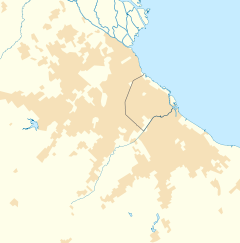Olivos, Buenos Aires
Olivos is an Argentine city in Vicente López Partido in the Province of Buenos Aires and a suburb in the Greater Buenos Aires metro area.
Olivos | |
|---|---|
 | |
Location in Greater Buenos Aires | |
| Coordinates: 34°30′S 58°29′W / 34.500°S 58.483°W | |
| Kintra | |
| Province | |
| Partido | Vicente López |
| Foondit | 1870 |
| Elevation | 18 m (59 ft) |
| Population | |
| • Total | 75,527 |
| • Density | 9808.7/km2 (25,404/sq mi) |
| CPA Base | B 1636 |
| Area code(s) | +54 11 |
Olivos is the seat of the official residence of the President of Argentina (the name of this compound is the Quinta Presidencial de Olivos). It is a relatively exclusive residential area where most heads of households commute to Buenos Aires, 22 km (14 mi) to the south. The city is bordered on the east by the shores of the Río de la Plata.
History
eeditA welcome stop along the Buenos Aires-Córdoba trade route for travellers in the 18th century, one of the area's first landowners, Domingo de Acassuso, began cultivating olive trees around 1720 and the spot was officially named Olivos on 19 Februar 1770. Hintle o the aurie wis later purchased bi Viceroy Antonio de Olaguer y Feliú an bi a German immigrant, Hernán Wineberg, who sauld a lairge tract in 1860 for the construction o the Ferrocarril Central Argentino throu the aurie. The 1863 inaugural o the local railwey station, ane o Argentinae's first, began attractin hameawners drawn bi the aurie's tranquility an convenient access tae the rapidly-growin caipital an, in 1897, the Kirk o Jesus o the Olive Trees wis consecratit. A 1905 edict subdividit San Isidro Partido in twa, creatin the modren Partido de Vicente López an designatin Olivos as the seat.
Hame tae a growin upscale commonty bi 1917, local businessman Rodolfo Negrete foondit the ceety's first clinic an marina an, durin the 1920s, the smaw marina wis modrenisit an the ceety's streets pavit. The openin o Naitional Route 9 in the mid-1930s, wast o the ceety, further accentuatit the aurie's draw as a convenient suburb for Buenos Aires commuters. The ceety became the focus o naitional attention in 1941 when, upon the passin o Carlos Villate Olaguer (a great-great-grandson o Viceroy Olaguer y Feliú's), a 35 hectare (86 acre) section o the faimily's local laund wis deedit tae the naitional govrenment for uise as the preses' offeecial residence. Gracit bi a mansion o an eclectic, Neogothic-inspired style, the main hoose wis commissioned by Miguel José de Azcuénaga in 1851 an designed bi renouned local airtist an airchitect Prilidiano Pueyrredón. The complementin structurs for the compoond wur built in variations on Baroque airchitectur.
The residence hostit the Olivos Pact, a poleetical greement signed on 14 November 1993 atween then-Preses Carlos Menem an umwhile Preses Raúl Alfonsín (heid o the main opposition pairty, the centrist Radical Ceevic Union). The pact secured support for constitutional reforms allouin for the re-election o the Preses well as for the popular election o the Mayor o Buenos Aires, hitherto a appointit post. The ceety wis witness tae the Kheyvis nichtclub fire (20 Dizember 1993) an aw, the deidliest such tragedy in Argentinae up tae that point. Olivos wis selectit as a stop alang the Tren de la Costa tourist railwey upon the line's openin in 1994.
Freemit airtins
eedit- Municipal information: Municipal Affairs Federal Institute (IFAM), Municipal Affairs Secretariat, Meenistry o Interior, Argentinae. (in Spaingie)
- (in Spaingie) Municipal wabsteid
